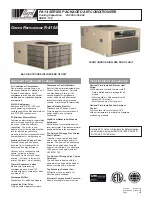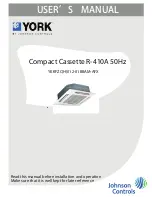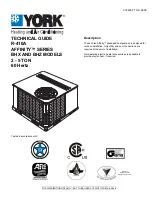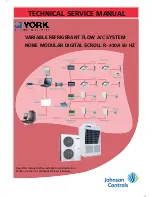
D
–EIMAC00907–16EN - 15/20
Unit Maintenance and Cleaning
Unit exposed to a highly aggressive environment can face
corrosion in a shorter time than ones installed on a standard
environment. Corrosion causes a rapid rusting of the frame
core, consequently decreases unit structure life time. To avoid
that, it is necessary to wash periodically the frame surfaces
with water and suitable detergents.
In case of part of unit frame paint came off, it is important to
stop its progressive deterioration by repainting the exposed
parts using proper products. Please contact factory to get the
required products specifications.
Note: in case of just salt deposits are present, it is enough to
rinse the parts with fresh water.
Microchannel Coil Maintenance
Routine cleaning of coil surfaces is essential to maintain
proper operation of the unit, avoid corrosion and rusting.
Elimination of contamination and removal of harmful residues
will greatly increase the life of the coil and extend the life of the
unit.
Relative to fin and tube heat exchangers, microchannel coils
tend to accumulate more of the dirt on the surface and of the
less dirt inside which can make them easier to clean.
The following maintenance and cleaning procedure are
recommended as part of the routine maintenance activities.
1.
Remove surface dirt, leaves, fibers, etc. with a vacuum
cleaner (preferably with a brush or other soft attachment
rather than a metal tube), compressed air blown from the
inside out, and/or a soft bristle (not wire!) brush. Do not
impact or scrape the coil with the vacuum tube, air
nozzle, etc..
NOTE: Use of a water stream, such as a garden hose, against
a surface loaded coil will drive the fibers and dirt into the coil.
This will make cleaning efforts more difficult. Surface loaded
fibers must be completely removed prior to using low velocity
clean water rinse.
2.
Rinse. Do not use any chemicals (including those
advertised as coil cleaners) to wash microchannel heat
exchangers. They can cause corrosion. Rinse only. Hose
the MCHE off gently, preferably from the inside out and
top to bottom, running the water through every fin
passage until it comes out clean. Microchannels fins are
stronger than traditional tube & fin coil fins but still need to
be handled with care.
It is possible to clean a coil with a high pressure washer
(max 62 barg) only if a flat shape of the water spray is
used and direction of the spay is kept perpendicular to the
fin edge.
If this direction is not respected the coil may
be destroyed
if using a pressure washer so we do not
recommend their use.
NOTE: A monthly clean water rinse is recommended for coils
that are applied in coastal or industrial environments to help to
remove chlorides, dirt and debris. It is very important when
rinsing, to water temperature is less than 550. An elevated
water temperature (not to exceed 550 C) will reduce surface
tension, increasing the ability to remove chlorides and dirt.
3.
Quarterly cleaning is essential to extend the life of an E-
coated coil and is required to maintain warranty coverage.
Failure to clean an E-coated coil will void the warranty
and may result in reduced efficiency and durability in the
environment. For routine quarterly cleaning, first clean the
coil with an approved coil cleaner. After cleaning the coils
with the approved cleaning agent, use the approved
chloride remover to remove soluble salts and revitalize
the unit.
NOTE: Harsh chemicals, household bleach or acid cleaners
should not be used to clean E-coated coils. These cleaners
can be very difficult to rinse out of the coil and can accelerate
corrosion and attack the E-coating. If there is dirt below the
surface of the coil, use the recommended coil cleaners as
described above.
Inverter Electrolytic Capacitors
Compressor Inverters include electrolytic capacitors which
have been designed to last a minimum of 15 years in normal
use. Heavy duty conditions may reduce the actual life of
capacitors.
The chiller calculates capacitor residual life based on actual
operation. When residual life gets below a give threshold, a
warning is issued by the controller. In this case replacement of
capacitors is recommended. This operation must be done only
by qualified technicians. Replacement must be carried out
through the following procedure:
Power off the chiller
Wait for 5 minutes before opening the inverter case
Check that residual dc voltage in the dc link is zero.
Open the inverter case and replace old capacitors
with new ones.
Reset the chiller controller through the maintenance
menu. This will allow the controller to recalculate the
new estimated life of the capacitors.
Capacitor Reforming after long shut-off period
Electrolytic capacitors may lose part of their original
characteristics if they are not powered for more than 1 year. If
chiller has been shut off for a longer period a “reforming”
procedure as follows is necessary:
Power on the inverter
Keep it powered on without starting the compressor
for at least 30 minutes
After 30 minutes the compressor can be started
Low Ambient Start-up
Inverters include a temperature control which allows them to
withstand ambient temperatures down to -20°C. However they
should not be switched on at temperatures lower than 0°C
unless the following procedure is executed:
Open the switchbox (only trained technicians should
perform this operation)
Open compressor fuses (by pulling the fuse holders)
or compressor circuit breakers
Power on the chiller
Keep the chiller powered on for 1 hour at least (this
allows inverter heaters to warm-up the inverter).
Close fuse holders
Close the switchbox
Service and limited warranty
All units are factory-tested and guaranteed for 12 months as of
the first start-up or 18 months as of delivery.
These units have been developed and constructed according
to high quality standards ensuring years of failure-free
operation. It is important, however, to ensure proper and
periodical maintenance in accordance with all the procedures
listed in this manual and with good practice of machines
maintenance.
We strongly advise stipulating a maintenance contract with a
service authorized by the manufacturer in order to ensure
efficient and problem-free service, thanks to the expertise and
experience of our personnel.
It must also be taken into consideration that the unit requires
maintenance also during the warranty period.
It must be borne in mind that operating the unit in an
inappropriate manner, beyond its operating limits or not
performing proper maintenance according to this manual can
void the warranty.
Observe the following points in particular, in order to conform
to warranty limits:
1.
The unit cannot function beyond the specified limits
2.
The electrical power supply must be within the voltage
limits and without voltage harmonics or sudden changes.
3.
The three-phase power supply must not have un
unbalance between phases exceeding 3%. The unit must
stay turned off until the electrical problem has been
solved.
4.
No safety device, either mechanical, electrical or
electronic must be disabled or overridden.
Summary of Contents for EWAD TZ
Page 17: ...D EIMAC00907 16EN 17 20...
Page 18: ...D EIMAC00907 16EN 18 20...
Page 19: ...D EIMAC00907 16EN 19 20...






































